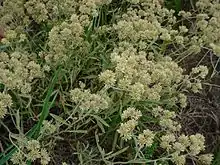Achyrocline saturejoides
Achyrocline satureioides, commonly known as macela or marcela, is a species of plant in the family Asteraceae. It is native to South America, from Argentina to Colombia to Guyana.[1] A semi-annual herbaceous plant reaching about a meter tall, it has simple, narrow green leaves with serrated edges. It produces yellow flowers in racemes around Easter.[2]
| Achyrocline saturejoides | |
|---|---|
 | |
| Scientific classification | |
| Kingdom: | Plantae |
| Clade: | Tracheophytes |
| Clade: | Angiosperms |
| Clade: | Eudicots |
| Clade: | Asterids |
| Order: | Asterales |
| Family: | Asteraceae |
| Genus: | Achyrocline |
| Species: | A. satureioides |
| Binomial name | |
| Achyrocline satureioides | |
| Synonyms | |
| |
Uses
It is used as the medicinal plant symbol of Rio Grande do Sul state in Brazil. This plant is widely used in various countries which share the Guarani cultural heritage such as Paraguay, Uruguay, and northern Argentina.[3] Where it is used to treat stomach, digestive, and gastrointestinal disorders during pregnancy.[4]
The species' extract, which contains isorhamnetin, luteolin, and quercetin, is used to fight herpes.[5] A. satureioides extract might have antiviral effects against the Western equine encephalitis virus. The extract could also have immunomodulatory properties. In general, it can help with management of viral respiratory infections, including SARS‐COV2 also known as Covid.[6]
A. satureioides could also have effects on rat pregnancy. The rats had reduced delivery index and neonatal survival after being supplemented with Achyrocline satureioides. This also has an impact on variations in tissue-specific redox homeostasis and enzymatic activity, especially in the liver and kidney.[4]
It is also used extensively in South Portugal, in bonfires during popular celebrations where people enjoyed the smell of burnt marcela and chorizos... when unavailable, people would simply open shellfish in the fire pit, eat them with a bit of lemon and make traditional constructions from the leftover shells, an art passed throughout multiple generations. [7]
The plant, or sometimes just the flowers, are used to make tea. The heads of the flowers are used to make medicinal wines and bitters. The flowers are also crushed up and put in a pillow to help sleep.[8]
References
- "Achyrocline satureioides - Useful Tropical Plants". tropical.theferns.info. Retrieved 2021-03-25.
- "Macela (Achyrocline Satureioides) 🏡 Gardening". Online Magazine. Retrieved 2021-03-25.
- Dellacassa, Eduardo (2012). "Marcela, a promising medicinal and aromatic plant from Latin America: A review". Industrial Crops and Products. Elsevier. 33 (1). ISSN 0926-6690.
- Moresco, K. S.; Silveira, A. K.; Schnorr, C. E.; Zeidán-Chuliá, F.; Bortolin, R. C.; Bittencourt, L. D.; Mingori, M.; Heimfarth, L.; Rabelo, T. K.; Morrone, M. D.; Carini, J. P.; Gelain, D. P.; Bassani, V. L.; Moreira, J. C. (August 29, 2017). "Supplementation with Achyrocline satureioides Inflorescence Extracts to Pregnant and Breastfeeding Rats Induces Tissue-Specific Changes in Enzymatic Activity and Lower Neonatal Survival". Biomedicines. 5 (3): 53. doi:10.3390/biomedicines5030053. PMC 5618311. PMID 29093434.
- Bidone J.; Argenta D.F.; Kratz J.; Pettenuzzo L.F.; Horn A.P.; Koester L.S.; Bassani V.L.; Simões C.M.; Teixeira H.F. (2015). "Antiherpes Activity and Skin/Mucosa Distribution of Flavonoids from Achyrocline satureioides Extract Incorporated into Topical Nanoemulsions". BioMed Research International. 2015: 1–7. doi:10.1155/2015/238010. PMC 4458523. PMID 26101767.
- Siqueira, Ionara; Simoes, Claidia; Bassani, Valquiria (August 5, 2020). "Achyrocline satureioides (Lam.) D.C. as a potential approach for management of viral respiratory infections". Phytotherapy Research : PTR. 35 (1): 3–5. doi:10.1002/ptr.6807. PMC 7436611. PMID 32757241.
- "Tradicionais Fogueiras e dos Santos Populares".
- "Achyrocline satureioides - Useful Tropical Plants". tropical.theferns.info. Retrieved 2023-08-22.
External links
- Achyrocline satureioides (in Portuguese)